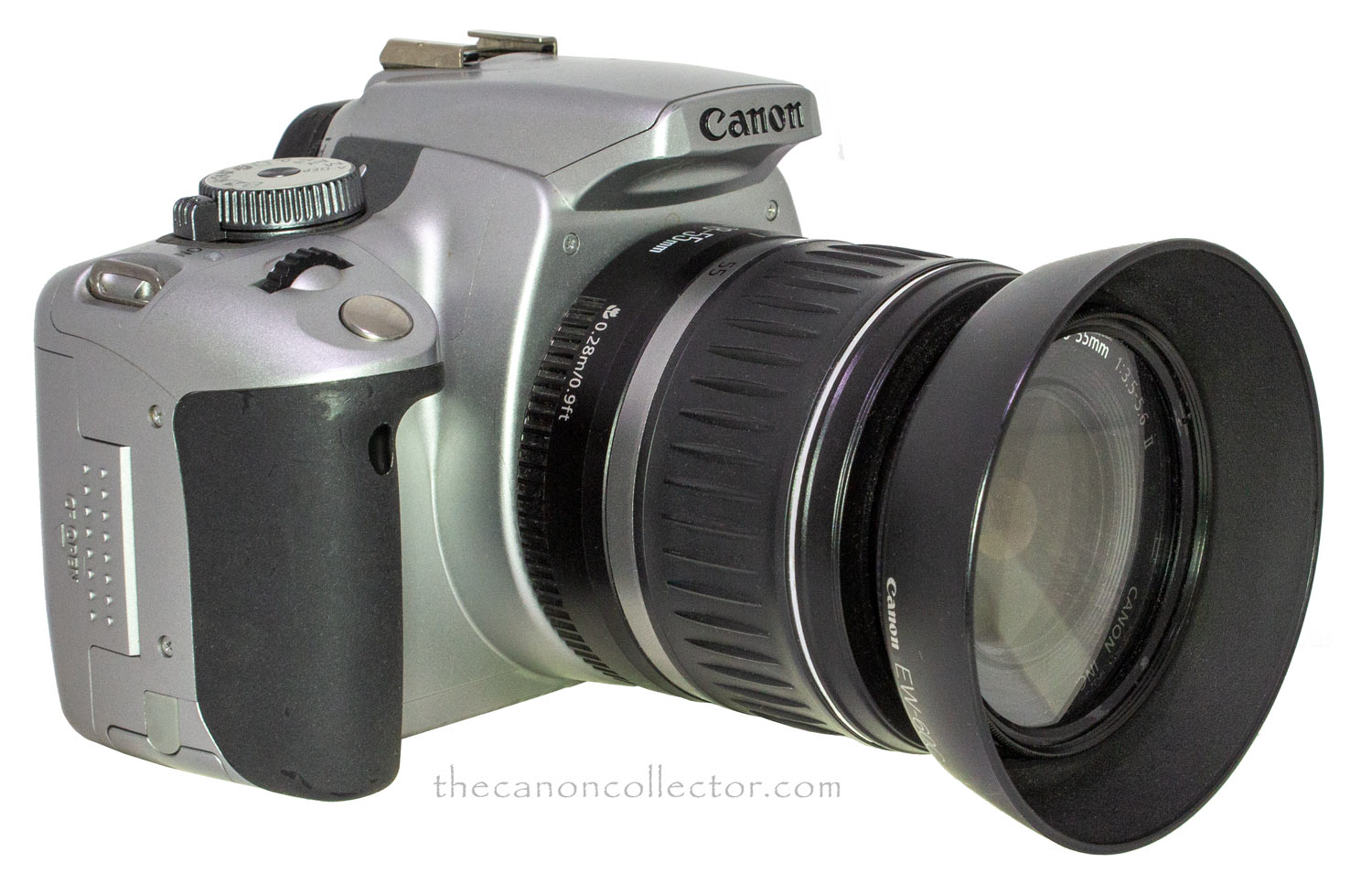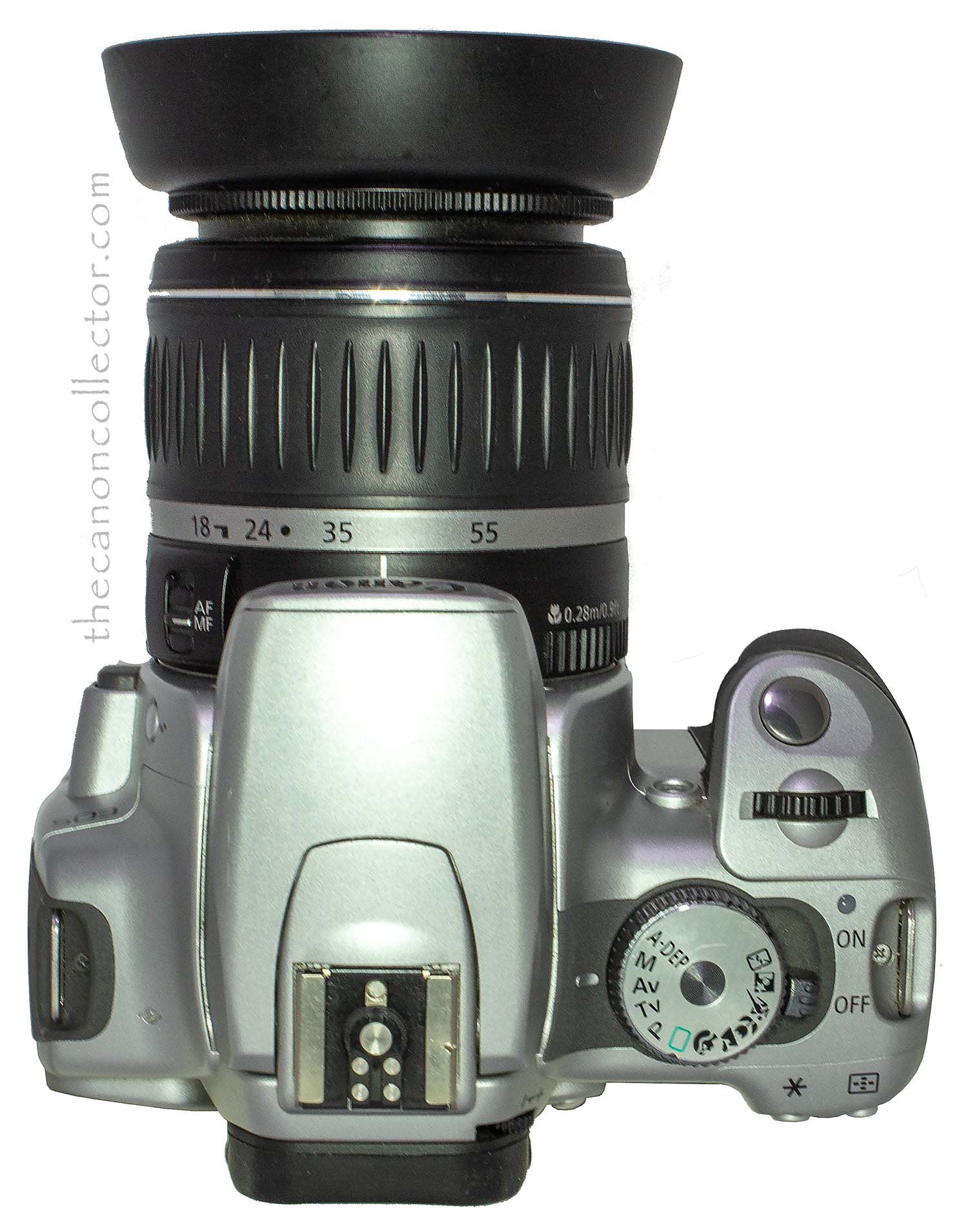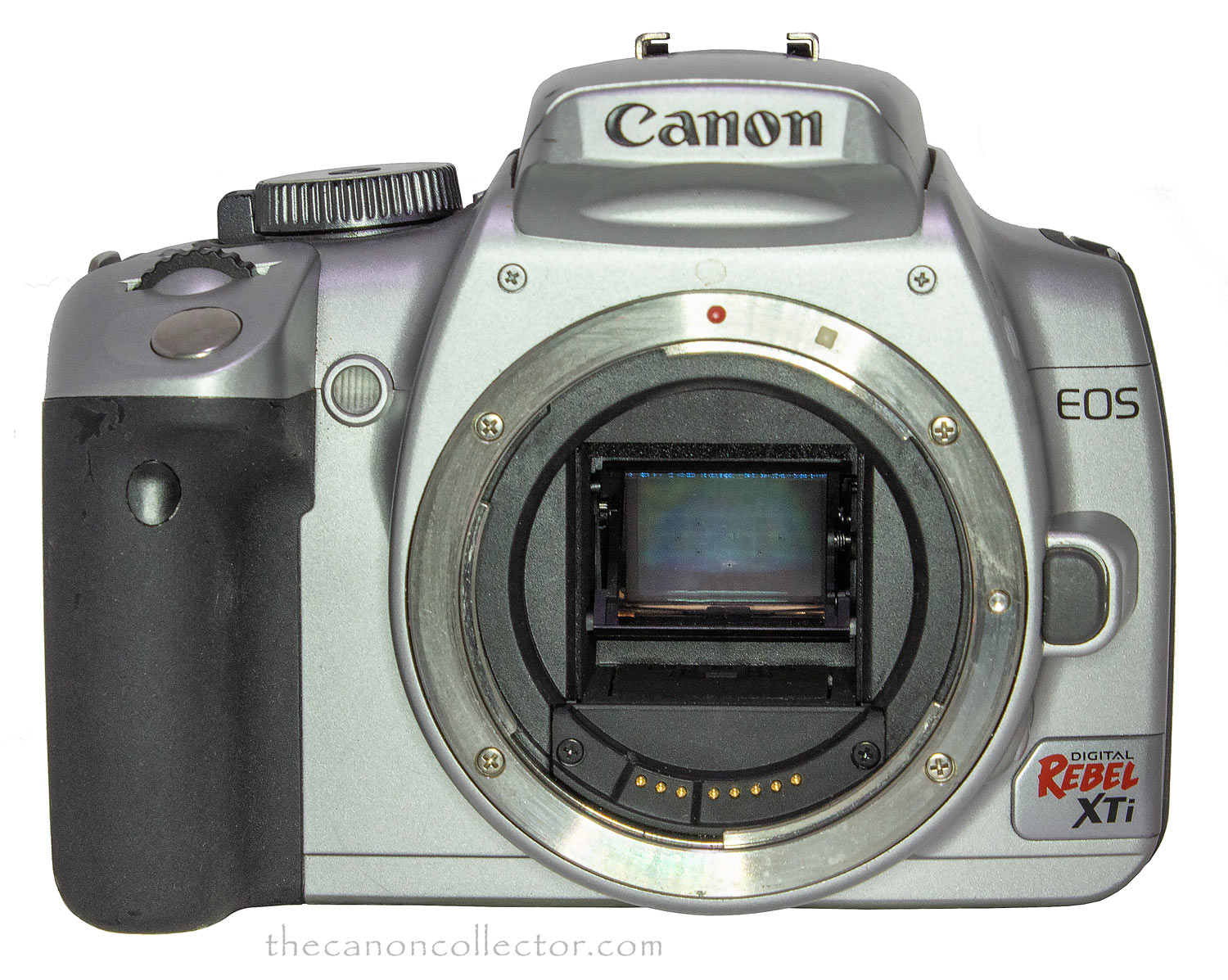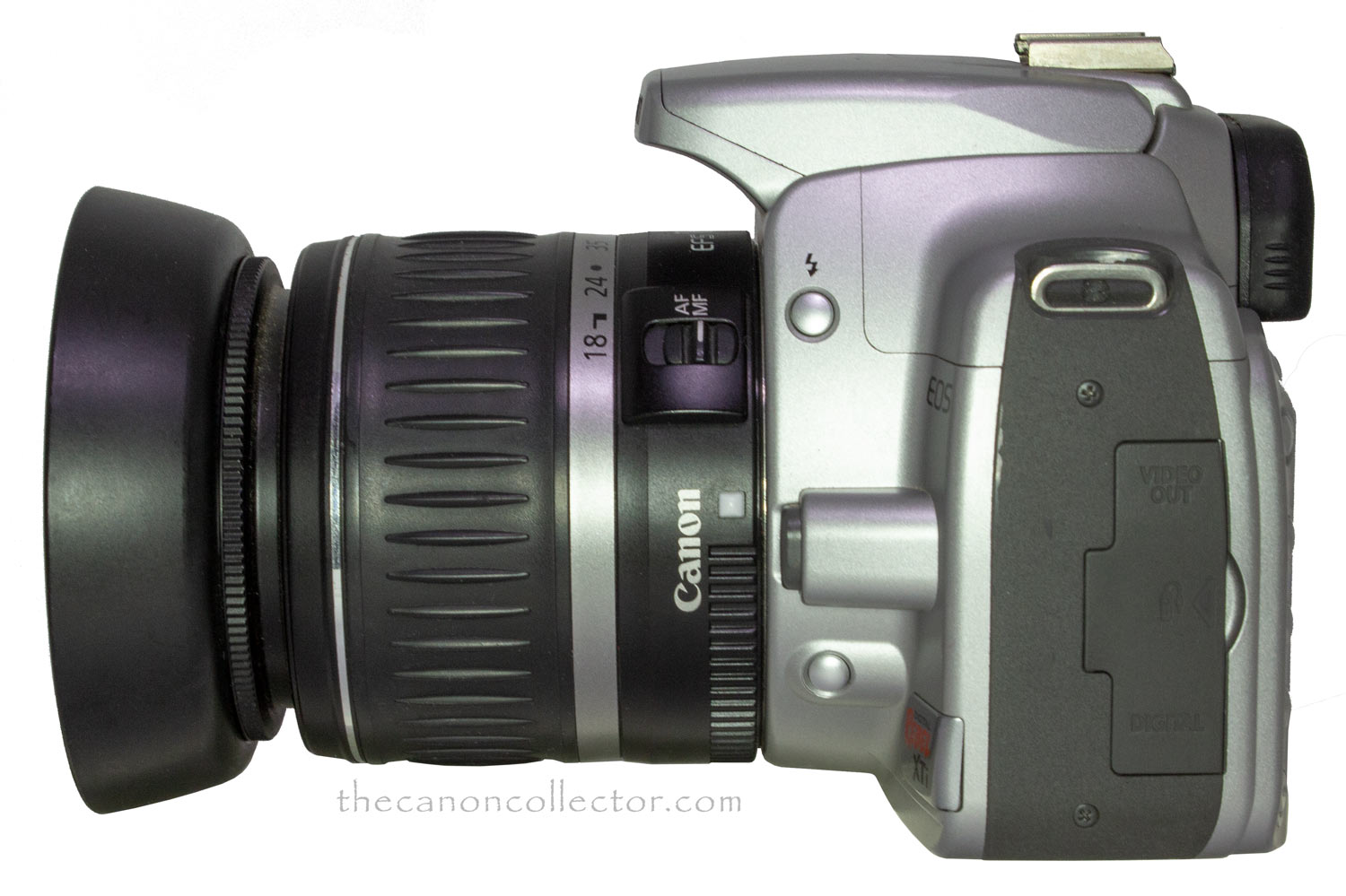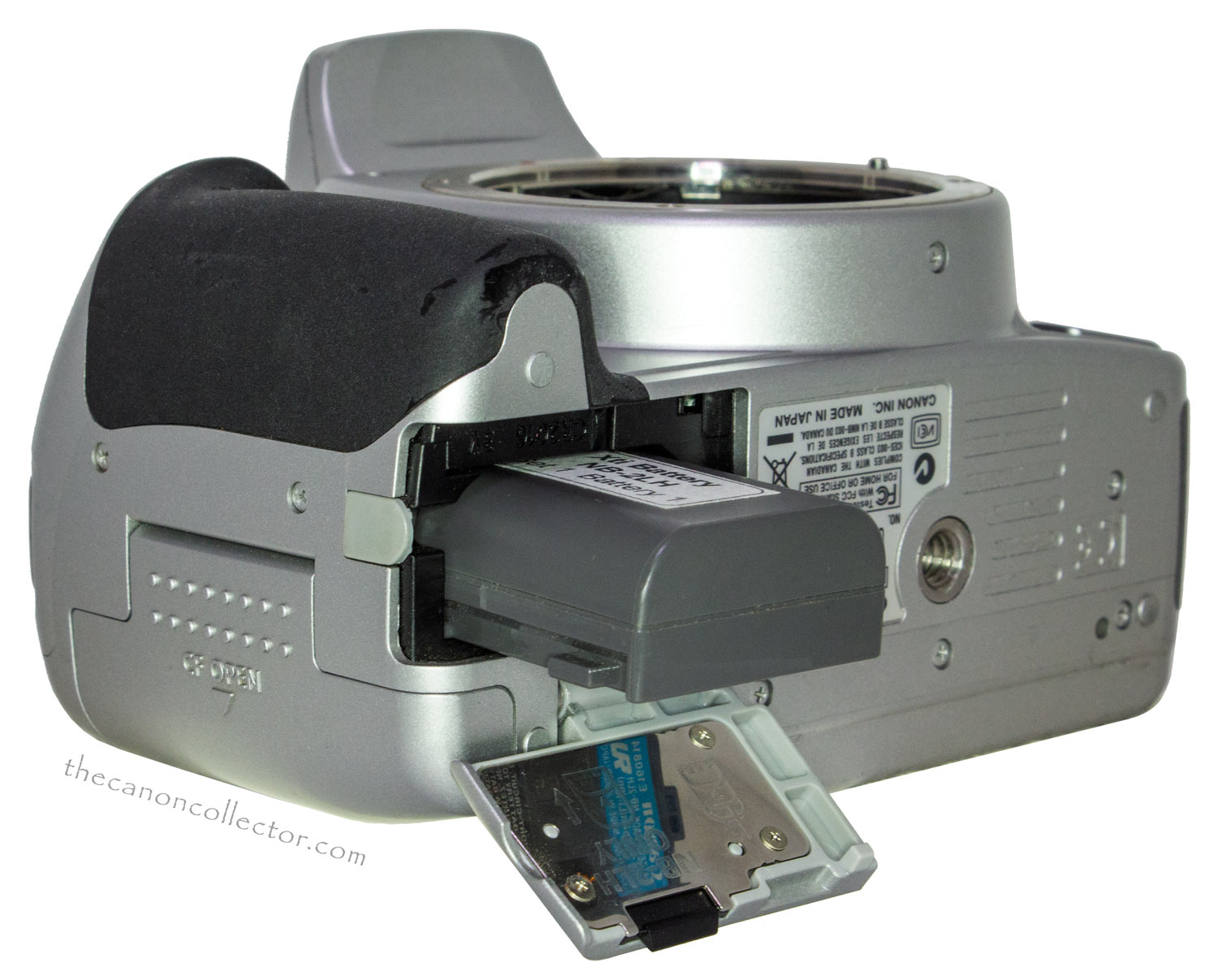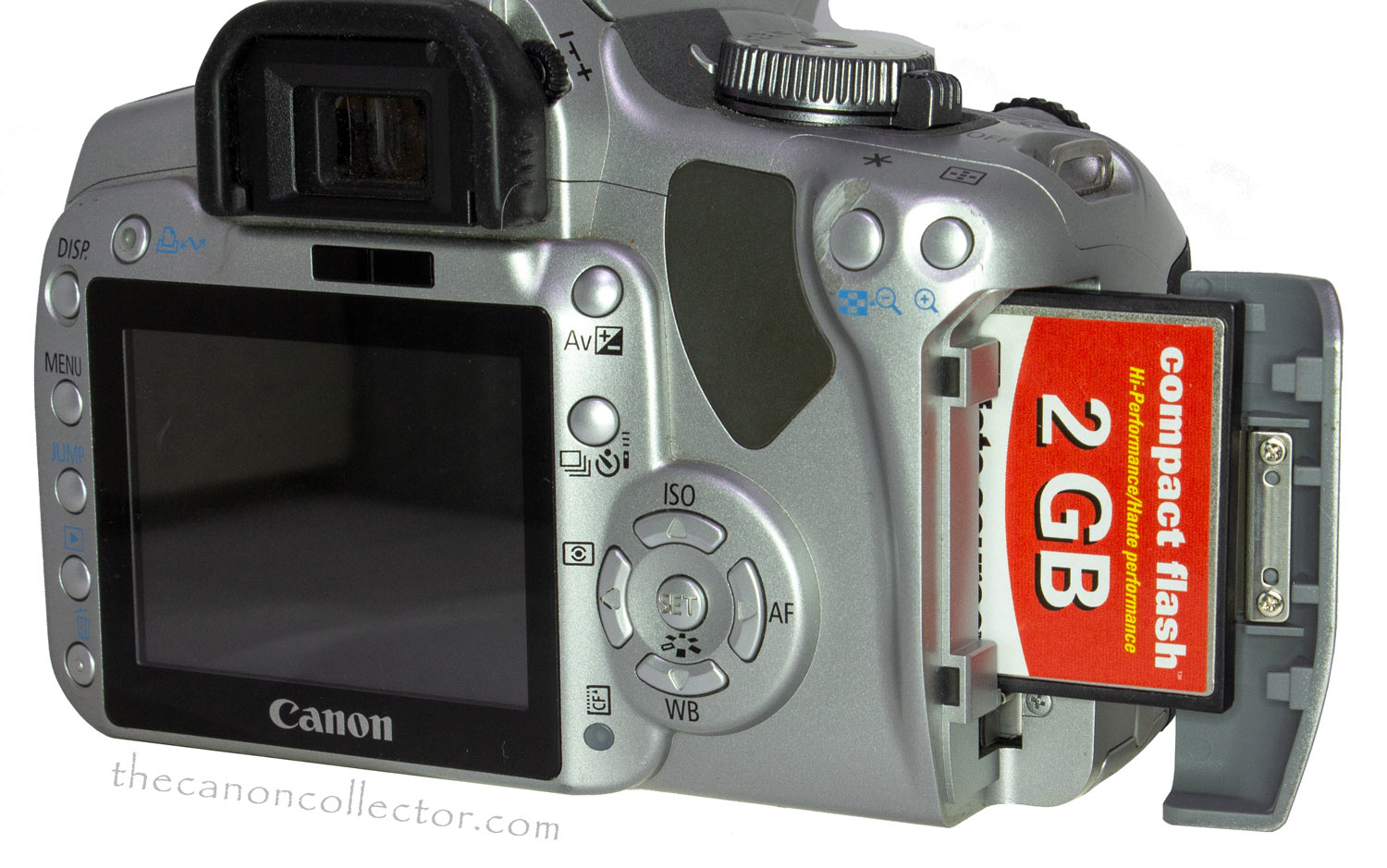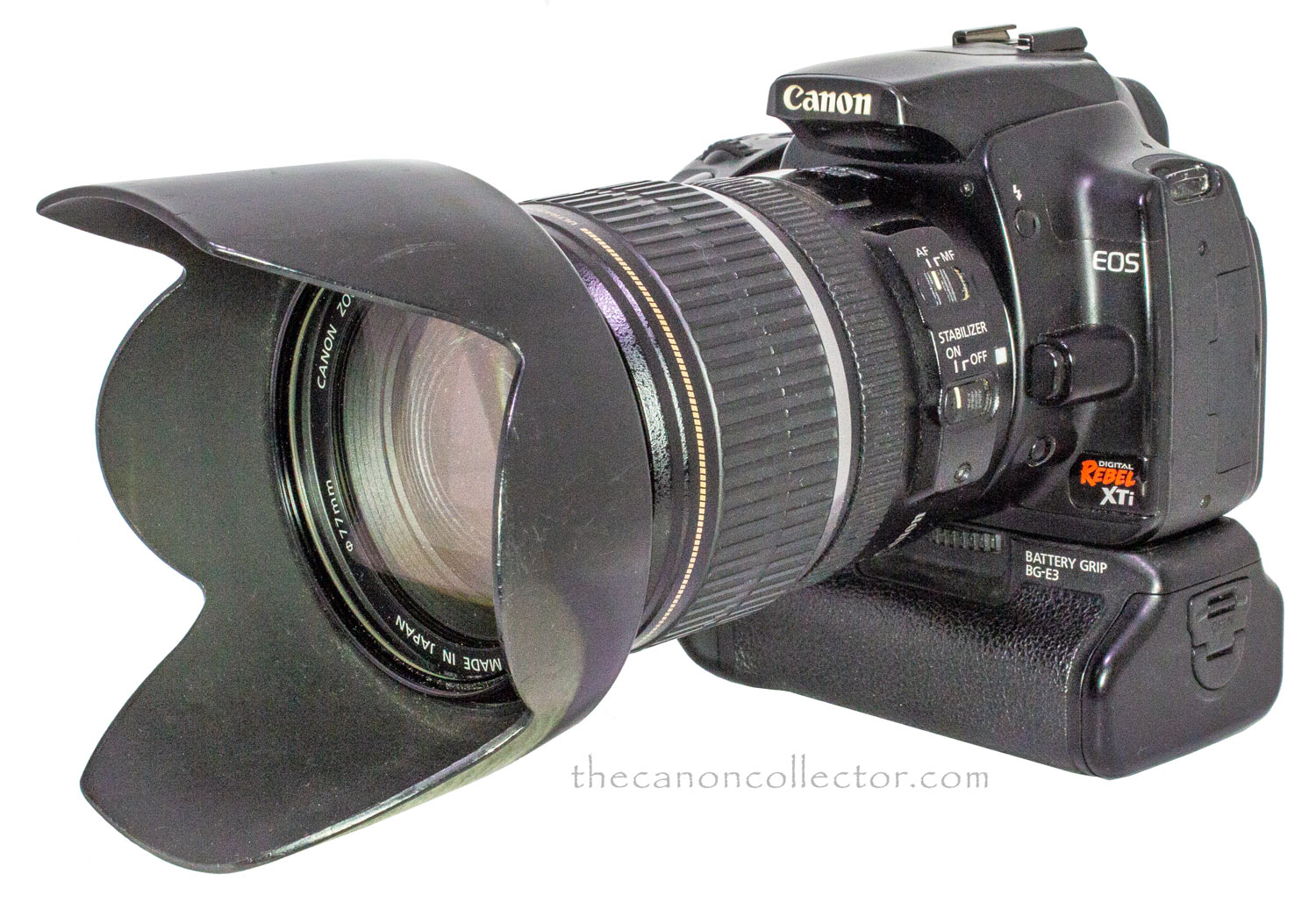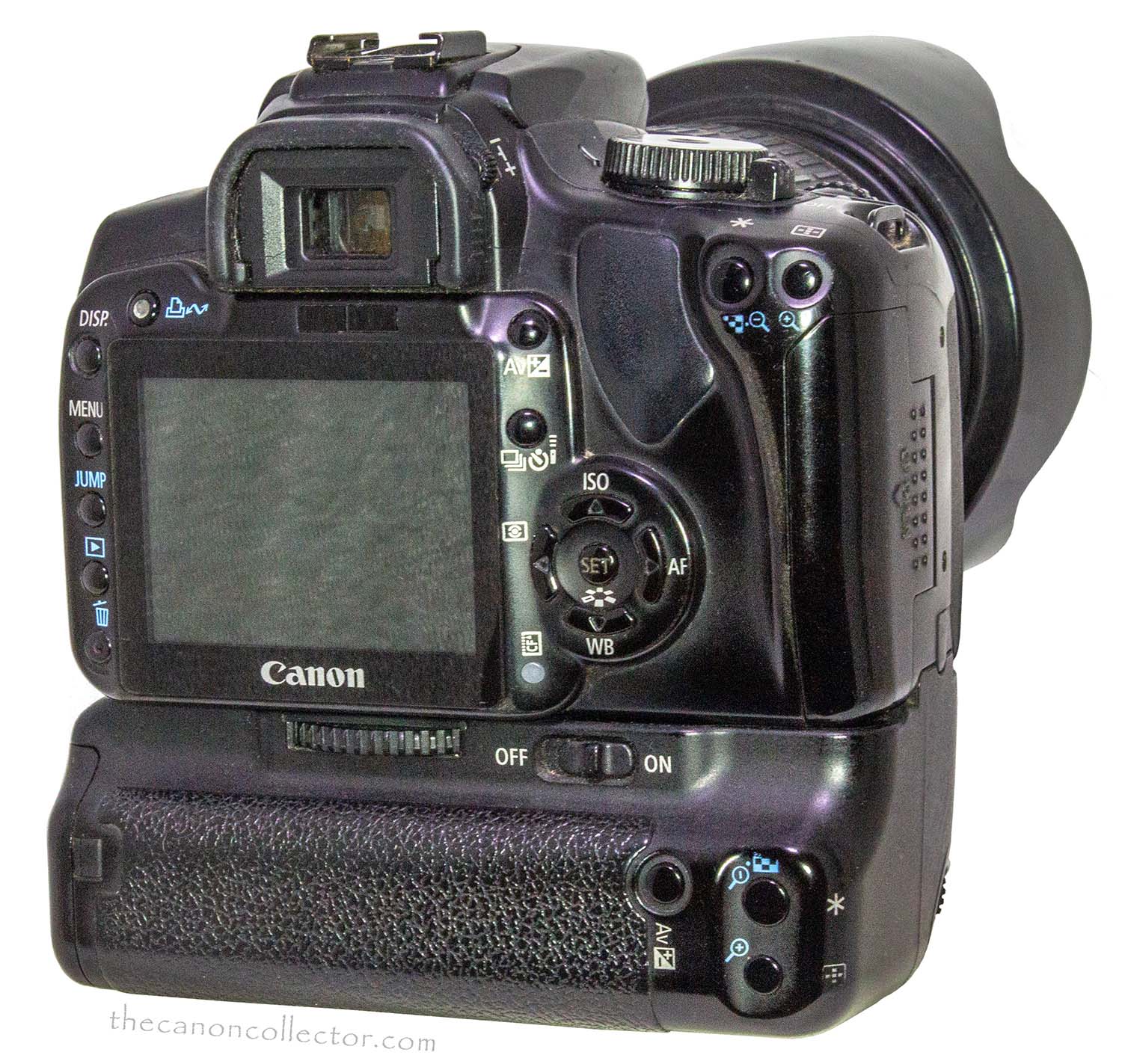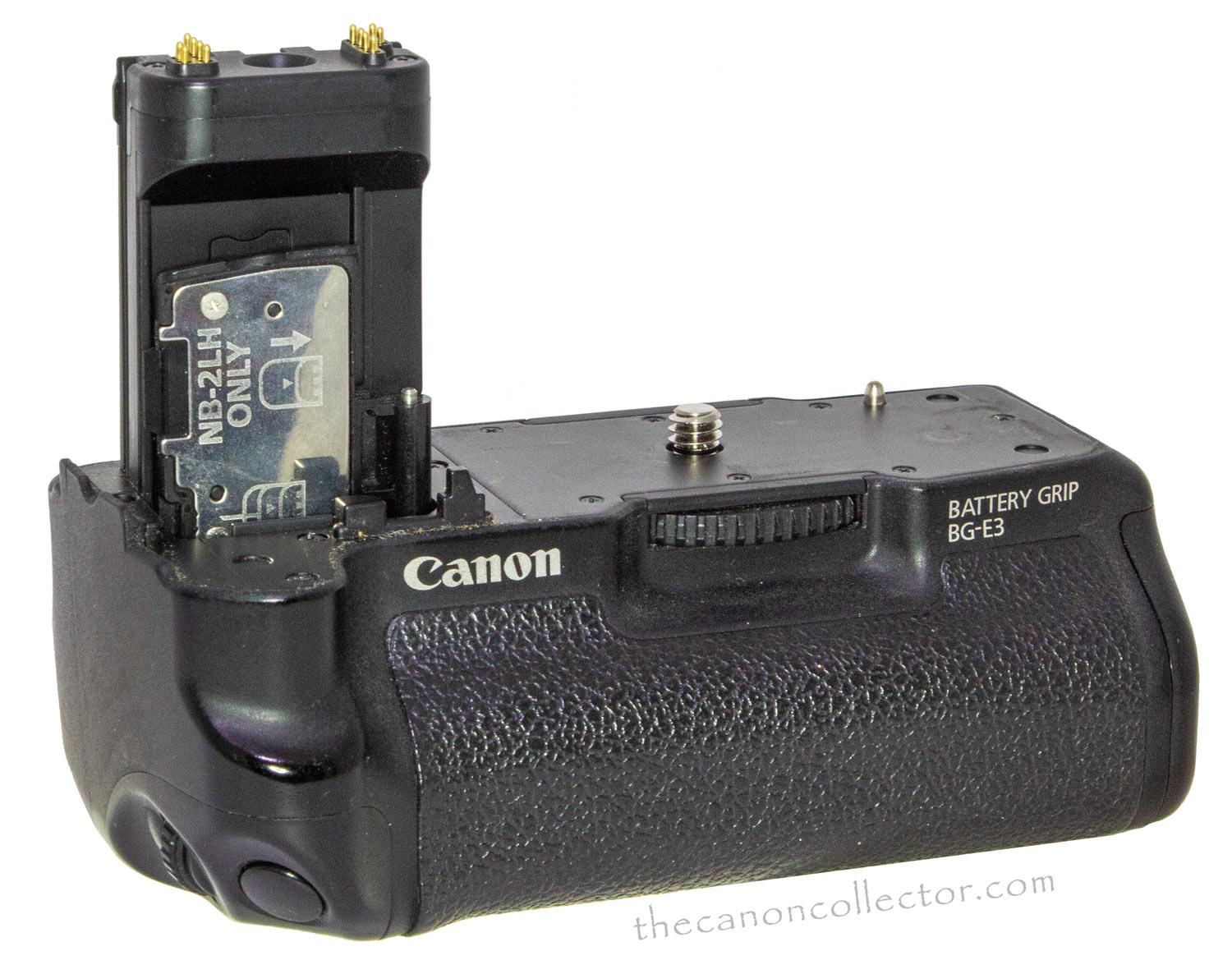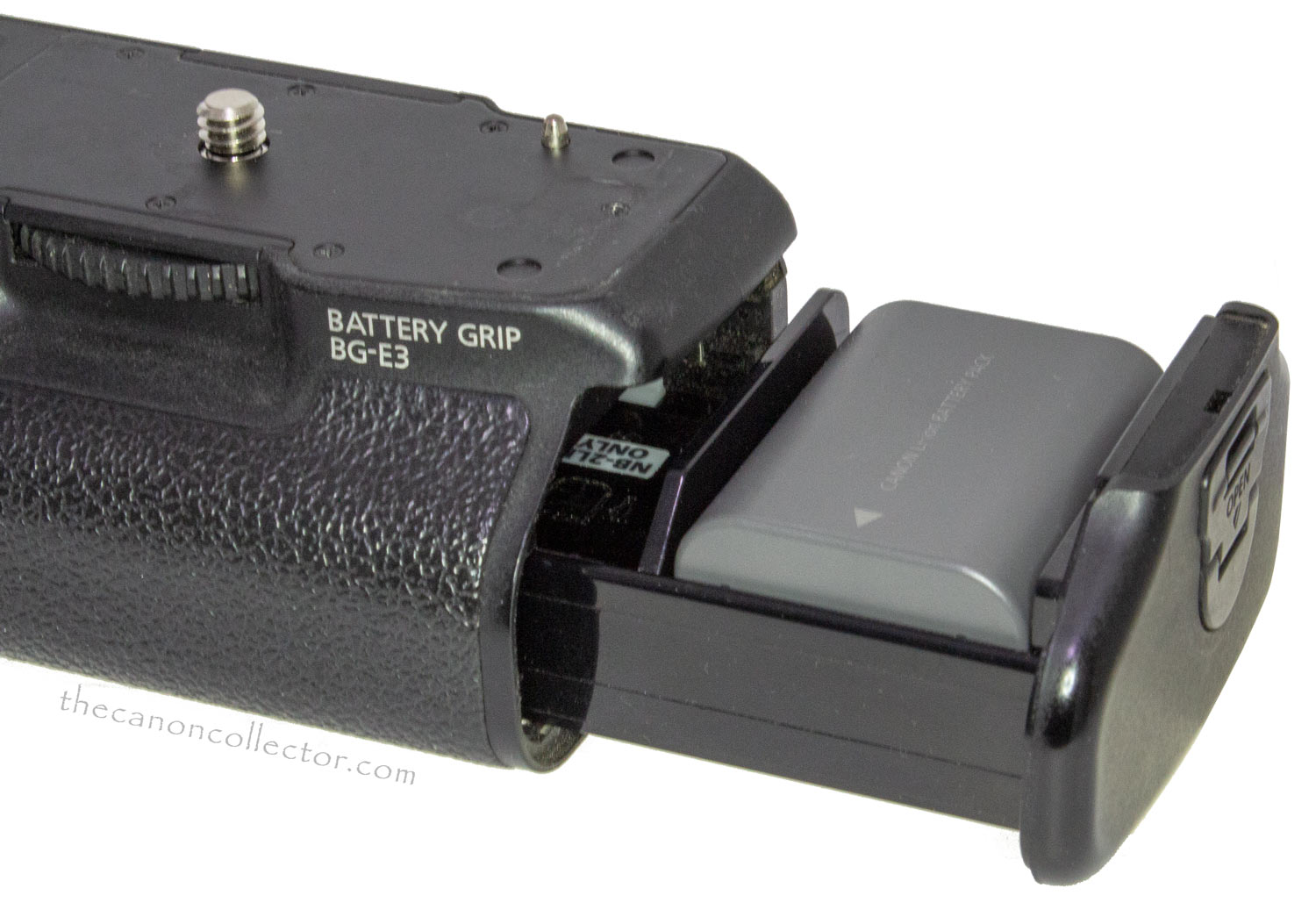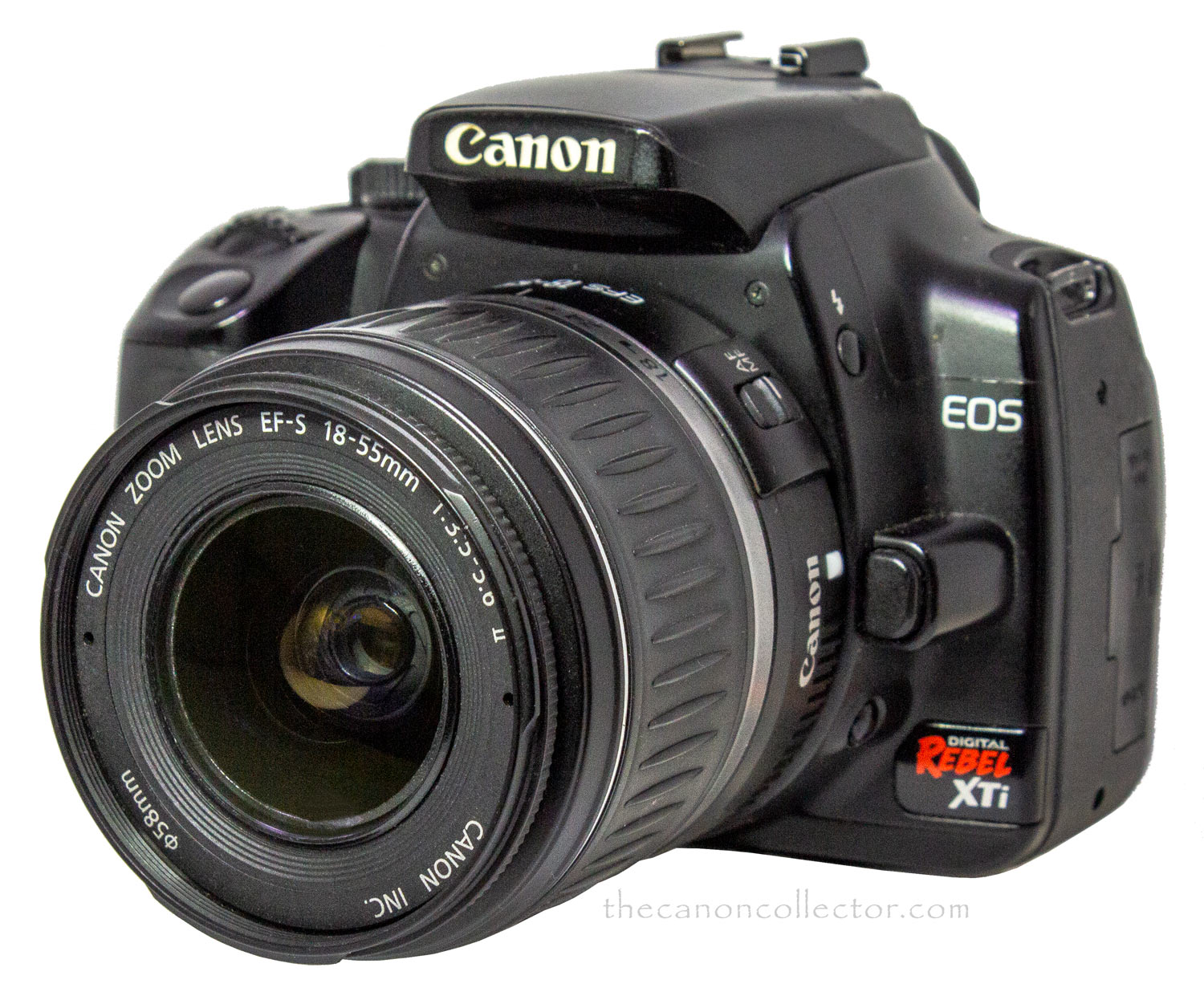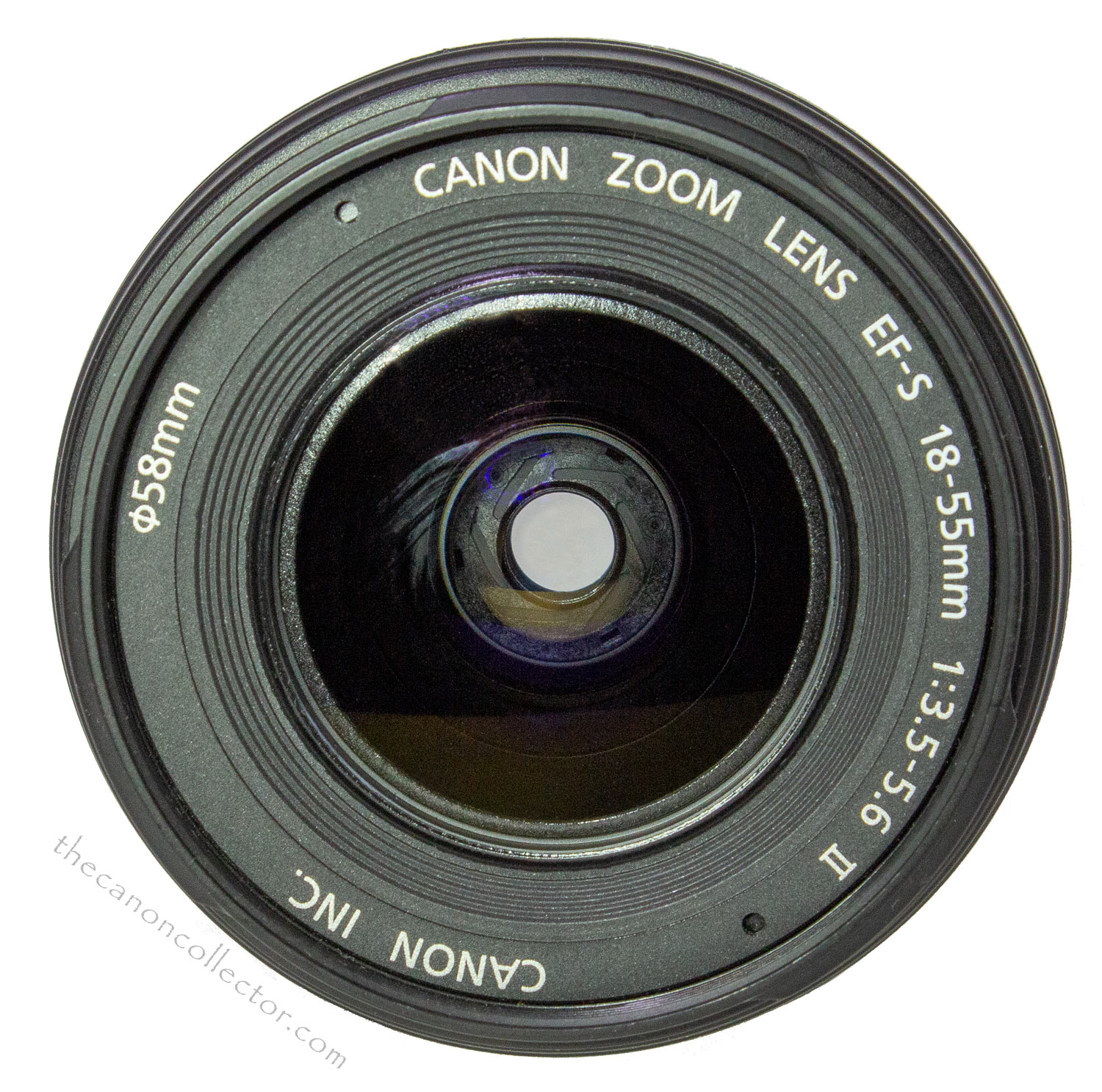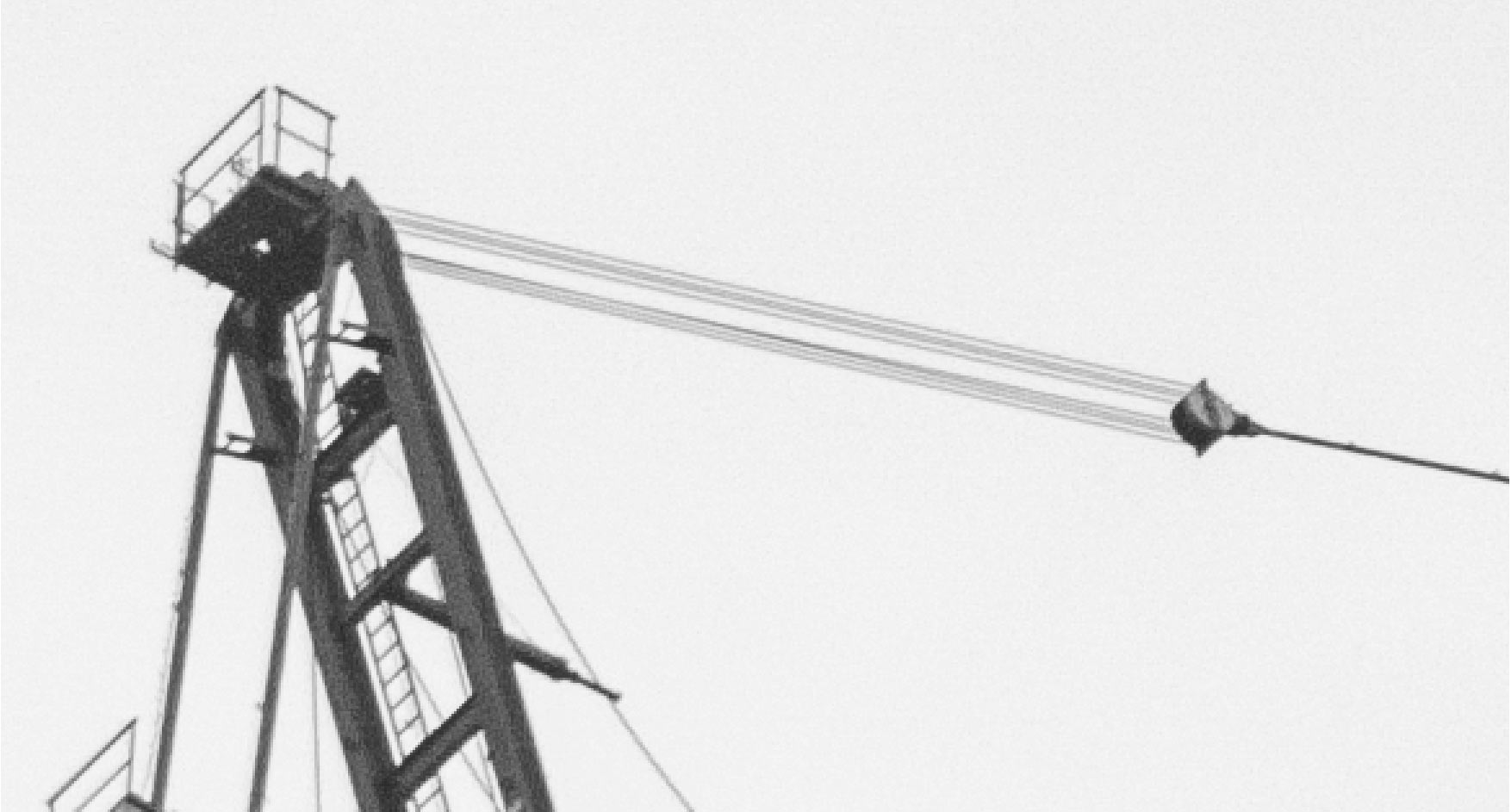My silver Rebel XTi with the EF-S 18-55mm f/3.5-5.6 II Kit Lens. The lens is sporting the EW-60C lens hood designed for it.
EOS Rebel XTi
I have to tell you up front that this is a biased review of the Canon Rebel XTi. You see, I love this camera. My first digital camera was a small 3.4 mpx HP Point and Shoot with minimal controls but it convinced me that I wanted to explore a serious digital camera. I shopped around and found the Canon EOS Rebel XTi at a camera store in New Westminster. I looked at it, went home and read about it, and decided to buy it. It was a black XTi ( it is pictured below) with an EF-S 18 to 55mm f/3.5-5.6 II lens.
I did something you should never do. Well, two things actually. Firstly I bought this new camera because Susan and I were going to Europe in a few weeks and I wanted this camera for the trip. A new unfamiliar camera before you are about to take important pictures is a risky thing.
The second thing I did was, while getting out of the car to board our plane a few weeks later, the camera fell out of the car about three feet down to the concrete parking garage floor. It cracked the case but we did not have time to worry about it. We had a plane to catch and getting on that plane I didn’t know if I had a functioning camera or not. It turned ut fine. It is a tribute to this camera that I was able to drop it like that and it did not miss a beat. It is functioning still to this day.
The top deck of the XTi is very simple: Shutter Button, Mode Dial and Main Dial. All of the basic camera functions are controlled here.
From the first time I used it I loved this camera. As an entry level camera it was able to take sophisticated pictures. I had all the controls I was used to on my Leica M3 and Minolta SR-1 but I got incredible images instantly. And I could shoot all day on a battery charge. So, I am biased towards the XTi. I shot with it until I began to want greater resolution and I bought a 60D years later. But I still use my XTi for snapshots and even for some of the photographs on this website. I have graduated to much more advanced cameras but my XTi for non-critical work eases the load on the shutters of my more advanced cameras.
So what about the Camera
The XTi (also called the EOS 400D in Europe and the Kiss Digital X in Japan) was introduced in September of 2006 as a replacement for the Digital Rebel XT. It was considered an entry level camera for the new or inexperienced user. If you check my
Camera Model Table you will see that the next level up, for the Enthusiast, at the time was the 30D and above that was the 5D. The camera was offered in Silver or Black but they were identical cameras. The one shown here is the silver version but my original XTi, shown below, was the black one.
The XTi is a smallish SLR and it is very light. You can carry it and almost forget you have it. Although it is not a pocket camera, it fits a very small camera bag. This is due to the use of lightweight plastics and a mirror prism instead of a glass one. And yet the camera feels solid and well built. It came with the standard kit lens which was the EF-S 18-55mm f/3.5-5.6 II (which is discussed below).
Positioning of the controls is where a Canon user would expect them to be. The LCD screen on the back is fixed and does not flip out or adjust viewing angle.
What I liked immediately was that all of the controls I was used to on my film cameras were available on this camera so the transition was easy. However, the added advantages of digital cameras, the instant review of the pictures, the unlimited number of exposures, the adjustable ISO settings, the easily selected focus points, all made the experience liberating.
There is no question that this camera is not as smooth to operate as the 5D or 30D, it takes a little longer to turn on or to focus, the ISO range (100 to 1600) is limited, but in spite of all of that this camera is still, in 2022, a great entry
level digital camera. And they can be found second hand for a fraction of what you would pay for a more updated model.
As an entry level camera all of the Rebels have the advantage of being able to use any of the Canon EOS lineup of lenses including the most professional of them. They may focus more slowly on the XTi but they function well. This makes this camera exciting.
The camera yields a 10.1 megapixel image in either JPEG or a Canon Raw version. The sensor is a CMOS design (one of these days I will do a page explaining the various types of sensors) and selectable ISO goes from 100 to 1600. Not the widest range by today’s standards but certainly acceptible for its intended audience.
Images are stored on Type I or Type II CF cards. Because the images are only 10 mpx they are not very big and you can fit hundreds on a card. You can select an sRBG or Adobe Color Space.
There is no point my going into the operation of the camera when you can simply read the manual for yourself. And as for a review of the camera you can do no better than to read the one at DPreview.com which is always a great source for information.
The XTi uses the 7.4 volt Li-ion Battery Pack NB-2LH rechargeable with the CB-2LW Battery Charger. Date and Time is maintained in the camera by use of a 3 volt lithium CR2016 button cell.
My First XTi was Black
As I said above, my first serious digital camera was a black Rebel XTi which I used extensively and loved. As I used it I found the limits of the kit lens and I bought new lenses for it: an EF-S 17-55mm f/2.8 IS USM and an EF-S 10-22mm f/3.5-4.5. Of course the XTi will also accept any EF lens which makes it all the more versatile. I also bought a Battery Grip BG-E3 which allowed me to load two NB-2LH batteries for greater endurance.
This is my original Rebel XTi. I bought various accessories for it such as the Battery Grip BG-E3 and the EF-S 17-55mm f/2.8 IS USM shown here.
The BG-E3 screws into the tripod socket on the bottom of the camera and conects to the camera through the battery compartment.
The battery tray in the BG-E3 accepts two rechargeable NB-2LH batteries and a second tray allows the use of the camera with AA alkaline batteries.
For five years I dragged my XTi to Las Vegas, Los Angeles, Palm Springs, Hawaii and on several trips to Europe, completely happy with it. I bought extra accessories for it and made some beautiful pictures. But after five years I was beginning to chaffe at some of the camera’s limitations. I wanted a wider ISO range, faster response time, an articulated LCD, I wanted to move up and in 2011 I made the jump up one level to a 60D. Great move but a story for another time.
This is my Rebel XTi that I bought in 2007 with the EF-S 18-55mm kit lens. I shot with this camera happily for several years and found this lens to be quite good.
A “Kit Lens” is the lens that usually ships with a camera body when they are sold together. These are usually good economy lenses but not the top of the line or professional lenses. My XTi shipped with the EF-S 18-55mm f/3.5-5.6 II which is shown here. Equivalent full frame focal lengths would be 29 to 88mm which is an excellent walkabout range.
This is a very light lens as a result of extensive use of plastic in its construction. Even the lens mount is plastic. This lens was first introduced in March of 2005 and first appeared on the Rebel XT. It has 11 elements in 9 groups (I don’t know why we care about the internal construction as there is nothing we can do about it). Aperture has 6 blades and the filter diameter is 58mm.
This is obviously an inexpensive lens and yet it is a real performer. It has always surprised me how good this lens is. It does have its limitations. There is no image stabilization and the f/3.5 to 5.6 is a bit slow. This is especially true when you realize that the ISO setting in
the camera only goes to 1600 and that is so noisy that you don’t want to go there. And the filter ring turns as you focus making the use of polarizing filters a pain. But hey, this is an entry level lens for an entry level camera.
I have said before in these pages that there is no point showing test images when discussing a camera body. The body has very little to do with image quality. Well, that is not totally true in that the body determines color space and dynamic range. But it does nothing for image definition and sharpness. At least in this camera. The modern advanced cameras do exercise software control of the image to eliminate weaknesses in lens design but this camera is not in that league.
In operation this camera-lens combination functions very smoothly. Focus is not as rapid as on my 5D but then the price is not in that league either. The viewfinder is a little dim as a result of the aperture of the lens and the use of a mirror prism (reflections in a true silvered glass prism are brighter than those in a mirror prism). Focus can be a little slow and low contrast subjects are a problem.
The front element is far forward in the mounting and really needs the protection of a daylight filter. I use it with a lens hood as well (Hood EW-60C) as that front element allows extraneous light to enter the lens and produce flare.
So, yes, this is an inexpensive lens with many shortcomings. But it can take pictures! In fact, I am often caught off guard by how good an image this lens can capture in spite of its limitations.
Above is the full image from the camera. In the top picture on the right you see a portion of the image at 100% magnification. Still a very nice image. Below that is the top of the crane at 300% magnification. Now, remember, this is a 10mpx camera and we are shooting near wide open at a relatively high ISO. And yet we have a good image. You see what I mean about this camera? It is amazing considering the target audience.
Have a look at this image on the left of a construction crane. It was taken with the lens above on my black XTi. It was an overcast day in Vancouver so I was shooting at an ISO of 400 at f/5.6. The lens was zoomed to 55mm so I was shooting at or near full aperture. It is not art but it will serve to show you this lens in action. This is a nice sharp image. I have increased the contrast and sharpened it further a bit in Lightroom.
But enough with the pixel peeking. The real question is whether the camera can take a pleasing picture. This camera is aimed at a certain category of people and the intent is to please them. By that test, this camera and lens pass with flying colors and more! In the hands of an experienced photographer it is capable of real art. Sure my 5D is a better camera and my Canon R is better still. They are easier to use, more capable, and way more money.
When I bought this camera I was thrilled with it and to this day I still am. I leave you with three pictures taken this fall. They show what can be done with an inexpensive entry level camera that is over 15 years old. And they are still available today on the second hand market and great prices. Buy one!
This is a slightly cropped image taken on a very cloudy day in downtown Vancouver. I was shooting at ISO 800 so the image has considerable grain. This was emphasized when I processed it in Photoshop and OnOne Effects. The point is, in difficult circumstances you can still make a good image with this camera-lens combination.
This is the full image taken with my Canon Rebel XTi and EF-S 18-55mm II lens. The lens is at its widest focal length and I am shooting at ISO 200 at f/8.0. Notice that the sun is in the pictire, peeking through the leaves of the tree and yet there are no stray light artifacts in the image.
This was a partially overcast fall day and I had to shoot at ISO 400 so that I could stop down to f/8.0. Focus point was the middle fencepost and you can see that by looking at the wires in the fence. I cannot recommend this camera enough, especially at the prices they sell for now!
This website is the work of R. Flynn Marr who is solely responsible for its contents which are subject to his claim of copyright. User Manuals, Brochures and Advertising Materials of Canon and other manufacturers available on this site are subject to the copyright claims and are the property of Canon and other manufacturers and they are offered here for personal use only.

